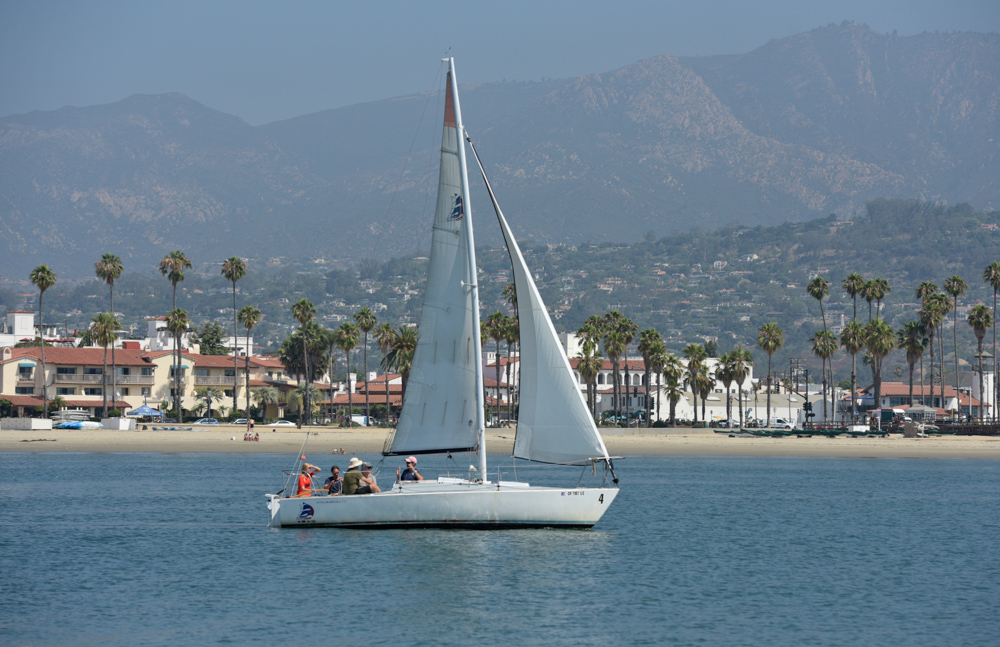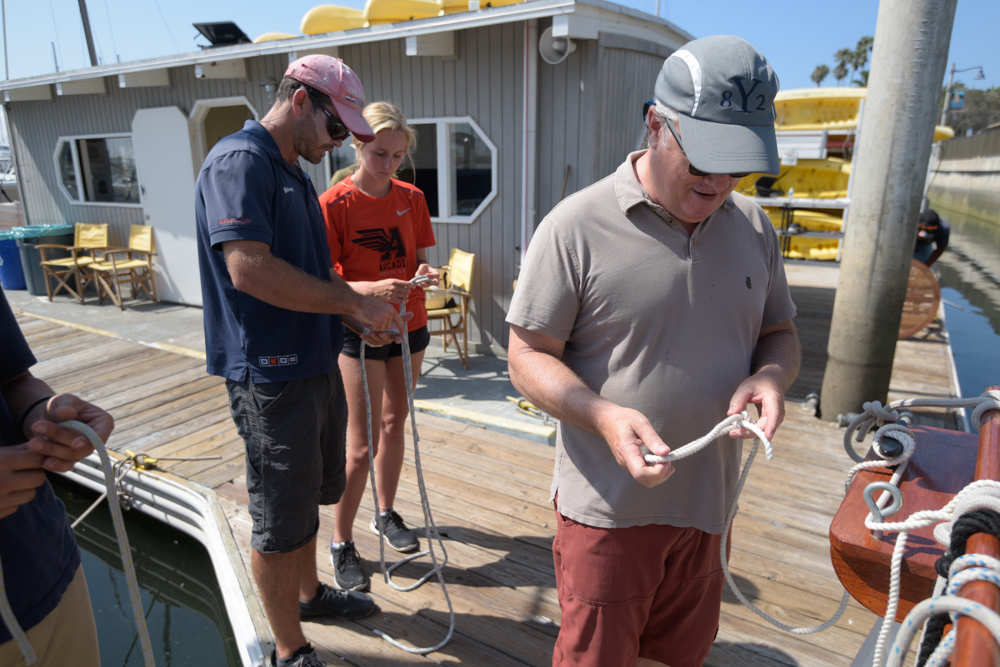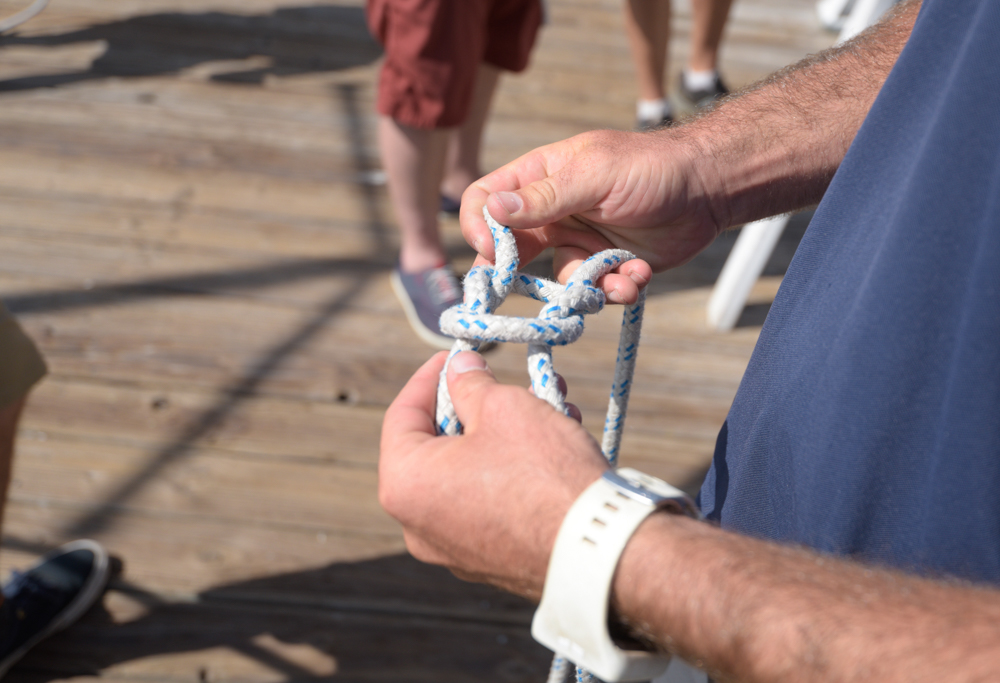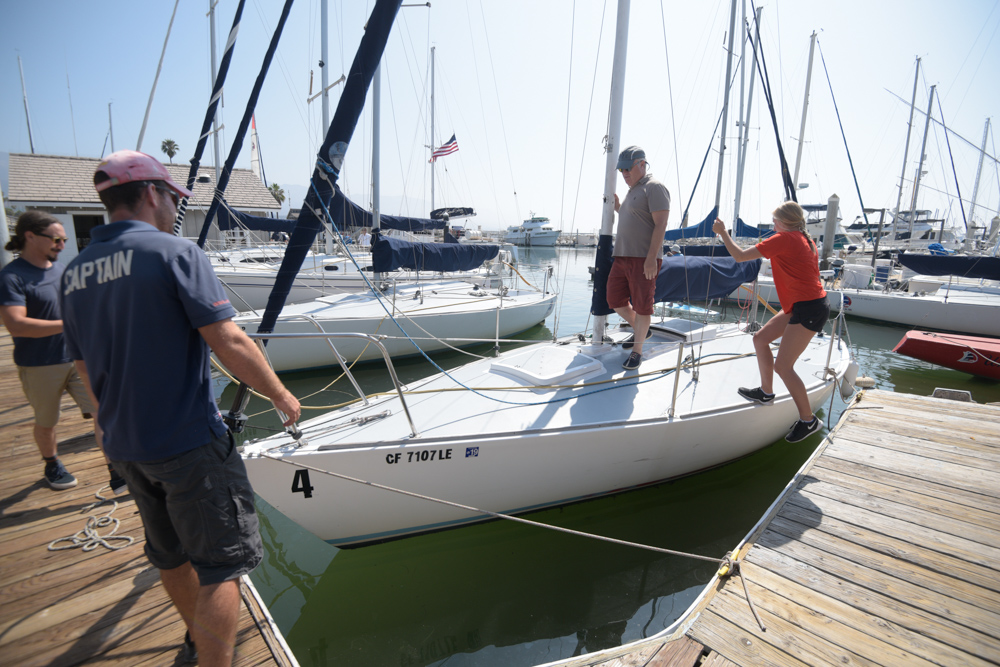Learning to Sail
ASA Certification at the Santa Barbara Sailing Center

The inspiring crescent of our city’s shoreline is one of the signature symbols of Santa Barbara; a great week of sailing instruction at the Santa Barbara Sailing Center turned my mental image of the waterfront upside down and inside out. Participating in one of Santa Barbara Sailing Center’s rigorous American Sailing Association (ASA) certification courses also taught me something new about the joy of encountering excellent instruction and the thrill of acquiring difficult new skills.
Skipper and Crew
In order to earn the ASA certification that allows you to charter from Santa Barbara Sailing Center, along with many other such centers around the world, you have to take at least 20 hours of in-person instruction and pass both written and “road” proficiency tests. In practice, this means devoting three full days to learning to sail — two six-hour instructional days followed by an eight-hour final with the written test in the morning, the “road” test at noon, and your group solo sail from 2 to 5 p.m.
The course is taught in groups of four, and that’s important because you must become a crew. Fortunately, I could not have been blessed with either a better skipper/instructor than Quincy Briscoe or a more able crew than my friend Wade Graham and the two young people we met through this experience, Michael, a recent Berkeley grad who manages a ranch in Goleta, and Annika, an undergraduate at Cal Poly and a whiz at all things nautical.

Although both Wade and I had done a significant amount of sailing as youths, Wade in particular having grown up windsurfing off Leadbetter Beach, we agreed that starting the ASA certification process from the beginning was the right choice. Hearing Quincy lay things out helped me remember what I had forgotten, and having him guide me through my first attempts in decades at handling a boat allowed me to relax and enjoy my turns at the helm. In 101, the object is to come out of day three capable of rigging and sailing anything up to 27 feet. Our vessel for this week of lessons was a classic J-24 sloop with a small electric outboard motor.
Day One: Knots and Landings
Knots are to sailing what code is to computing — there’s more to sailing than knots, but without them, you can’t do it at all. Tying a knot correctly once or twice does not mean that you’ll tie it right the next time, and tying a knot under pressure, or without looking, or when you are in any way distracted? Those are all totally different from watching someone else tie one and then following their instructions. That’s why you practice.
A lot of things have changed since my days hiking to windward on Rhode Island’s Narragansett Bay, and one of the most impressive improvements is the electric outboard motor. Nearly silent, relatively tiny, and easy to master, it made launching from our tight inside slip a pleasure instead of a chore. Learning to launch with the motor gave a preview of the qualities that make someone a good crew member. Focus, the ability to listen, an unflappable demeanor, a determined disposition, the ability to be quietly and completely present — these were just some of the strengths I observed as I got to know my worthy shipmates. Like Annika’s sudden smile after nailing a difficult maneuver, Mike’s cool under pressure as he tried something he’d never done before made me realize I was in luck to have drawn such a great group.

A lot of the credit for how well we got along has to go to Quincy. Standing in the companionway of the cabin, he radiated the confidence we needed to feel in order to succeed as a team. He introduced me to two things on day one that were not a part of my sailing education as a kid and that struck me as indispensable. The first was heaving to, which is much nicer than it sounds, and involves throwing the boat into a kind of pleasant neutral. The second was reefing the mainsail, which made a big difference in our ability to handle the ship after the wind kicked up in the late afternoon.
Days Two and Three: Drills Make You a Sailor; Certification Lets You Sail
Days two and three are ingeniously engineered to get everyone through the final exams, both on paper and on the water. First there’s a chalk talk in which Quincy teaches you the points of sail, the rules of the road, and the signals, lights, and buoys. It’s in a classroom on the dock, but don’t worry, you will get plenty of time on the water during day two.
Once out of the harbor, we began the core exercises that would turn us from landlubbers into fledgling sailors — man overboard and docking. In ASA 101, you learn to tack, jibe, and trim your sails, but you don’t practice them all by themselves. As with knots, everything you learn comes in the context of an exercise that shows how it is used. For coming about and sailing on a specific course, there’s the man-overboard “figure eight.” For tacking, jibing, and knowing the rules of the road, there’s docking. Each drill presents a particular challenge, and neither is easy. Fortunately, man-overboard drills, which are conducted at sea, do not require that anyone leave the boat. The “man” is an orange lifejacket, and Quincy keeps throwing “him” overboard until you are ready to say, “Forget it; let him swim.” I found the man-overboard drill the most deeply satisfying thing we learned. Here’s why.
To start with, that orange lifejacket could be you. If you can’t consistently go back and get someone who fell overboard, sailing ceases to be a recreational activity and becomes more like aquatic roulette. The figure-eight technique we learned requires discipline and teamwork. Like many of the most important things in sailing, it’s both counterintuitive — you have to sail directly away from the person for a significant distance in order to eventually save them — and is unforgivingly precise. Skip one step and you risk not only failing to recover 1MOB; a false move could easily result in the catastrophic 2MOB.
Docking drills, while less likely to conjure images of drowning, nevertheless routinely present opportunities for collision. On an average weekday afternoon in the summer, the Santa Barbara harbor presents an unending stream of vessels of virtually every description. In order to complete just one landing, it’s entirely possible that you will have to avoid a power boat, a pleasure yacht, some day sailors, half a dozen kayaks, 10 or 12 SUPs, Little Toot, the Double Dolphin, and a vacationing family pedaling a paddle boat. Docking under sail in these conditions requires acute vision and hearing, teamwork, boat-handling skills, knowledge of the rules of the road, judgment, and luck.

Friday found us in the classroom once more, faced with 100 multiple-choice questions on everything from leeches to luffs, air horns, fire extinguishers, and flares. Quincy turned the road test into a casual sail during which everyone completed their maneuvers without ever noticing they were being assessed. And finally, after receiving our certifications at 2 p.m., we set off for our first certified solo sail. Outside of the harbor on a glorious Friday, we were quickly surrounded by acrobatic kite foilers who entertained us with incredible, balletic tacks and jibes. In just a week, we had become sailors, and there was no going back. Except to the dock, because someone else had chartered the boat.
For information about learning to sail at Santa Barbara Sailing Center, call (805) 962-2826 or visit sbsail.com.



